Bangladesh’s water crisis: A story of gender
Climate change is driving an acute water crisis in coastal Bangladesh in which women are bearing most of the strain.
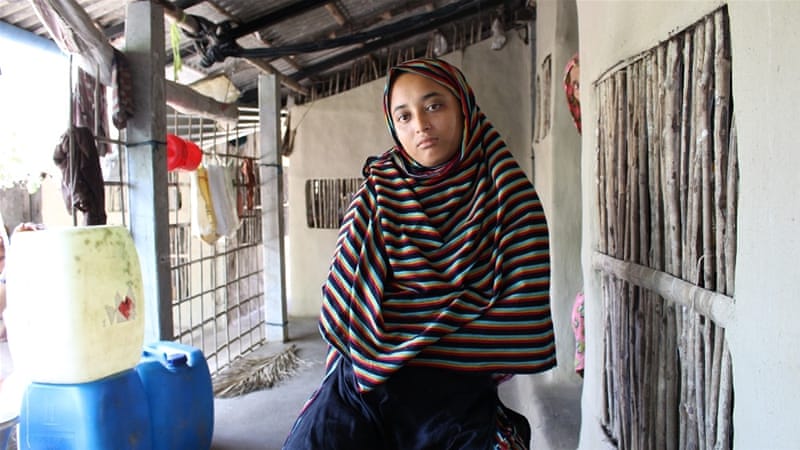

By
Neha Thirani Bagri
Neha Thirani Bagri is a writer whose work focuses on gender, politics, development, environment, and social justice
Kochukhali, Bangladesh – When Khadija Rahman, then a newly married 14-year-old, moved to the Satkhira district on Bangladesh’s southwest coast, she didn’t realise just how much the scarcity of drinking water in the region would affect her.
Now, 10 years later, the cheerful young woman finds that the shortage plagues her daily life.
Her village, Kochukhali, lies near the Sundarbans, one of the largest mangrove forests in the world, at the edge of the Ganges delta, where water intrudes on the low-lying land and shallow ponds and rivulets proliferate across the landscape.
IN PHOTOS: Surviving climate change in Bangladesh
A combination of tidal flooding, inundation by storm surges and saltwater intrusion has led to a rise in salinity in the groundwater and the fresh-water ponds. As a result, in the coastal area of Satkhira, potable water is a scarce and precious commodity.
“We can’t drink the saline water, can’t take a bath with it. If the utensils are washed with this water they get damaged, even for cooking we have to bring water from far,” says Khadija. “In the beginning, I couldn’t adjust here, but now I am getting habituated with the salty water.”
The impact of the acute drinking water crisis in Bangladesh is borne disproportionately by women who, like Khadija, are the family members traditionally responsible for collecting water.
Water crisis: a women’s issue
 |
| Khadija holds her son, Muttakin Amir, who is now nearly five years old. Because of the salty water in the area, he often falls sick [Neha Thirani Bagri/The GroundTruth Project] |
During the monsoon season, the shortage of drinking water in the village somewhat abates, as Khadija, like many others in the region, collects rainwater in plastic buckets and drums. In the dry summer, the water level in the shallow pond near Khadija’s house shrinks by nearly a metre and the little water that remains gives off a sharp odour.
In the scorching summer sun, Khadija is forced to walk about an hour to a community water pump in Jelekhali village and back again, the loose end of her threadbare sari covering her head, her blue rubber slippers slapping against the hot cement of the winding road.
She carries an aluminum pot, which are ubiquitous in every household in the area; so integral to the lives of the women that they are often presented as wedding gifts.
Most days, she faces a prolonged wait in a winding line by the pump. In the course of each day her family needs at least three or four aluminum pots filled with water, forcing her to make multiple trips – once at about 7am and then again at about 4pm when the sun begins to go down – and each time the process takes over an hour.
About 70 percent of people in the region depend on pond water for drinking and domestic use, as the groundwater is extremely saline, according to Golam Rabbani, a fellow at the Bangladesh Centre for Advanced Studies.
The daily struggle is being exacerbated by climate change. Over the past 35 years, salinity intrusion in Bangladesh has increased by about 26 percent, with the affected area expanding each year.
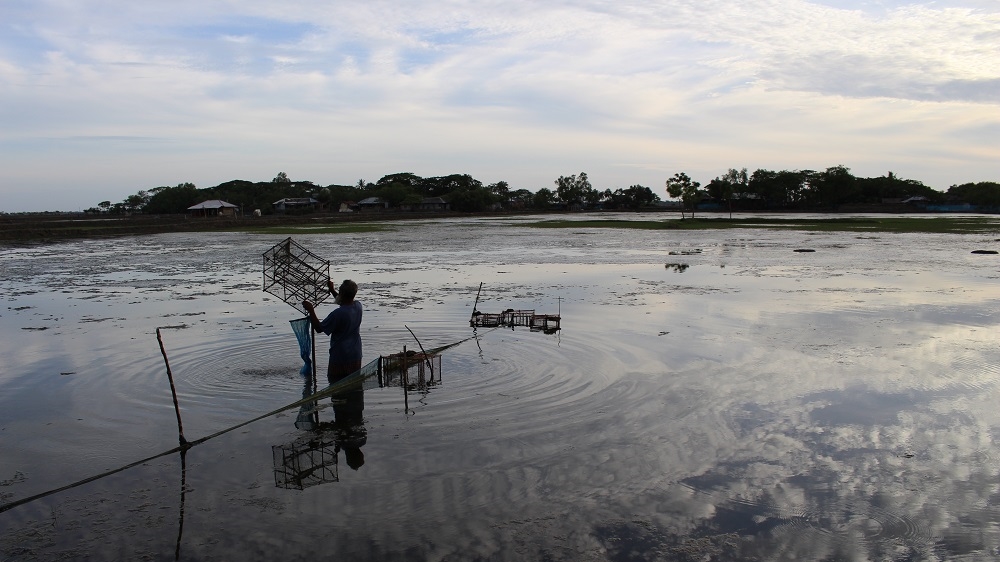 |
| A shrimp farmer collectis the day’s catch at dusk. While the salt water makes it hard to cultivate rice, the traditional crop in the area, shrimps thrive in it [Neha Thirani Bagri/The GroundTruth Project] |
According to a study by the World Bank, climate change is likely to further increase river and groundwater salinity dramatically by 2050 and exacerbate shortages of drinking water and irrigation in the southwest coastal areas of Bangladesh, adversely affecting the livelihoods of at least 2.9 million poor people in a region where 2.5 million people are already struggling with a lack of water.
As water sources dry up and demand increases, women like Khadija are forced to walk further and further to provide water for their families.
|
|
The increasing salinity of the soil in Bangladesh’s coastal villages has not just made safe drinking water hard to come by; it has also made rice farming, the region’s traditional occupation, nearly impossible, while the shrimp farms that thrive in the salt water and have become pervasive in the region do not need many day labourers.
The lack of work has driven large-scale migration to Dhaka. Many, such as Khadija’s husband Habibur Rahman, end up in Bangladesh’s congested capital city, trying to make a living as garment factory workers, rickshaw drivers and security guards – sending back money at infrequent intervals.
Habibur decided to move to Dhaka when he was 15, nearly two decades ago, because he found it hard to find work in Kochukhali. He now works long days making shirt collars in a garment factory and returns to the village every three months for about five days.
Many like Habibur migrate seasonally or for large portions of the year, leaving their families behind. Households in areas of coastal Bangladesh affected by salinity have a higher out-migration rate for working-age adults, according to a report by the World Bank.
GALLERY: Climate change in pictures
Landless labourers who are facing livelihood challenges and have large households with many dependents are most likely to migrate, Rabbani explains. “About 90 percent of the people who migrate are men, leaving the female members of the household behind.”
The World Bank estimates that 400,000 people from different parts of Bangladesh move to Dhaka each year. And according to a study carried out by the International Organization for Migration, that surveyed 160 migrant households in Dhaka, 66 percent said that they were forced to migrate because of changing climate conditions and environmental hazards, Rabbani says.
With her husband away in Dhaka most of the year, Khadija, who dropped out of school when she got married, now spends her days cleaning the house, cooking for the family, fetching water, washing dishes and caring for her son.
 |
| Women gather around the water pump in Fultala. In the rainy season, the line at the pump is shorter as women collect rainwater in plastic drums and pots. [Neha Thirani Bagri/The GroundTruth Project] |
Every month, Habibur sends her about 4,000 Bangladeshi taka ($50) through bKash, a money remittance service in Bangladesh that allows money transfers through mobile phones.
But Khadija often finds that the money is spent before the end of the month, and sometimes Habibur is unable to send any.
“Problems are unpredictable,” says Khadija. “Often we are empty handed.”
She finds herself borrowing money from her neighbours or shopkeepers in town, which she tries to repay the following month if Habibur’s wages come in.
Khadija has a small patch of earth near her mud-and-bamboo house, where she plants spinach, bitter gourd and ladyfingers during the rainy season. But this monsoon, she says, “there hasn’t been sufficient rain”.
Clean water for a price
To add to Khadija’s expenses, the lack of available drinking water has turned water into a commodity.
“Everybody in the area who can afford it purchases water,” says Ainun Nishat, professor emeritus at the Centre for Climate Change and Environmental Research at BRAC University in Bangladesh. “About 10 percent of their income goes to buying water.”
In recent years, many entrepreneurs have begun to filter water and sell it in the area.
 |
| A truck delivers drinking water to a village on Bangladesh’s southwest coast. Potable water is a scarce and precious commodity in this region [Neha Thirani Bagri/The GroundTruth Project] |
Amirulla Gazi, a tall, reedy man with skin weathered by the elements, began to sell water in Kochukhali village 16 years ago. Each day, he buys 30 litres of water from the tube well at the bazaar and sells it to households in the village.
Since Cyclone Aila in 2009, the demand for water has increased – driving up the price. “People who used to get water for free are getting more habituated to paying for water,” Gazi explains. “They don’t take it for granted any more.”
In the peak of summer, when even the pumps are dry, Khadija’s family is forced to buy water in drums. Each blue plastic drum of water costs her 10 Bangladeshi taka (12 cents), and she needs a number of drums each week for the family, putting even more strain on her finances.
|
|
“How can you make do without water? If you need it and it is not available you have to find a way to get it,” says Khadija. “We get drinkable water from wherever we can.”
Khadija’s woes are not uncommon. A study by United Nations Women and the Bangladesh Centre for Advanced Studies found that food and water are the primary concerns among women on Bangladesh’s southwest coast whose husbands had migrated due to climate change.
The study found that most women did not receive enough financial support from their husbands and some did not receive any. Some women also faced harassment in their communities and had an increased fear of theft in the absence of the male member of the household.
This pattern of temporary displacement has resulted in a shifting social contract in the region.
“Despite not being widowed or divorced, the women in these areas are managing a female-headed household while the men are away,” explains Dilruba Haider, a programme coordinator for Gender and Climate Change, at the Bangladesh country office of UN Women.
“They are struggling to take care of their children and household chores. There is a feeling of insecurity when the men are not around,” Haider adds.
 |
| Savitri Mundo waits by the water pump in Fultala. Her husband, Bibhuti, now works in Dhaka as a security guard and comes home every three months [Neha Thirani Bagri/The GroundTruth Project] |
Socio-cultural norms that restrict the movement of young women in male-dominated public spaces make it even harder for women to live on their own, buy groceries, earn a living or access medical care.
Community members often make disparaging comments about women who venture out to the village market, visit their children’s schools or go to the doctor in town by themselves.
When Khadija’s husband visits home, he buys things such as oil and rice that she can store. But when he is not around, Khadija has to ask other people to do her shopping, or take her son to the doctor.
She does not work because her husband does not approve of it, but other women in the village pick up work as day labourers when they can find it, pitching in on shrimp farms or helping out with the harvest when crops are cultivated. However, almost no women from her village go to Dhaka for work.
READ MORE: Who is affected by climate change, and how?
For a brief period before they had a child, Khadija lived with her husband in Dhaka, and looks back at that time fondly. While her house in the village does not have electricity, in the city she had a “pucca” (cement) house. They bought gas cylinders so she did not need to cook on a wood-burning stove, and there was a near-constant water supply.
When her husband had a day off work, they visited the zoo or the children’s park, and watched Hindi movies. But the best part of the city was the freedom it afforded her.
“In Dhaka, we could move about independently with no one to control,” Khadija recalls. “Here there are so many people watching, so there is less independence.”
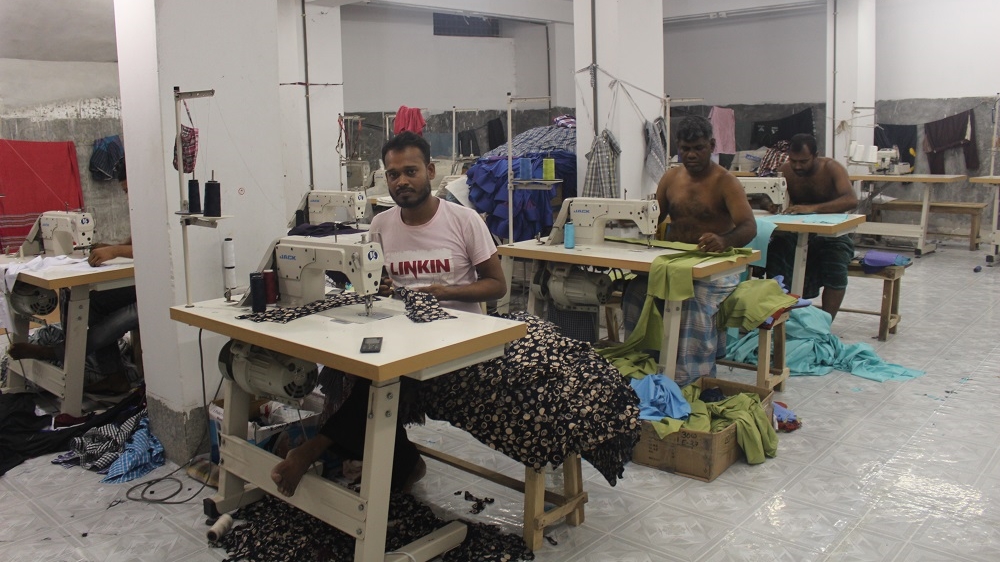 |
| Khadija’s husband Habibur sewing in a garment factory in Dhaka. He typically works 12 hours a day in the factory [Neha Thirani Bagri/The GroundTruth Project] |
When Khadija was six months pregnant she moved back to her husband’s village because he could not financially support both his wife and son in the city. But she soon found herself sick, frequently getting dysentery and scabies, and her hands and feet would swell up.
She was in a lot of discomfort, and decided to move to her parents’ home, more than 300 kilometres away in the Kaliganj district near Dhaka, until her child was three months old.
The saline water in the area has a particularly negative impact on maternal health.
‘If I fall sick, who will take care of him?’
Aniere Khan, a researcher at the International Centre for Diarrhoeal Disease Research in Bangladesh, carried out a study with Imperial College London which surveyed about 1,500 women on the southwest coast of Bangladesh and found much higher rates of preeclampsia and hypertension during pregnancy in coastal areas, as compared with non-coastal districts. Women complained of swollen arms and legs, and complications during pregnancy.
“The saltier the water they were drinking, the higher the association with high blood pressure and preeclampsia,” Khan explains.
|
|
The study found that the salinity levels in coastal water sources were much higher than levels deemed acceptable by the World Health Organization.
Exposure to saline water – especially during the final months of pregnancy – leads to an increase in infant mortality and illness, according to a 2015 World Bank study in coastal Bangladesh.
Khadija’s son, Muttakin Amir, who is now nearly five years old, often falls sick. Khadija and her son both regularly get severe bouts of diarrhoea and have to visit the doctor, and bathing in the pond water in the summer gives her scabies.
The rising salinity of the water on Bangladesh’s southwest coast has caused several diseases to proliferate in the area. Many are tied to natural disasters or occur seasonally. Habibur Rahman Khan, the doctor in charge of the main government hospital in the district, says that he saw an increase in diarrhoea, dysentery, gastric illnesses, skin diseases and malnutrition after drinking water sources were contaminated by natural disasters such as cyclones.
“It is hard but I have to take care of my son all alone, as his father is far away,” says Khadija. “If I fall sick, who will take care of him?”
Bangladesh: on the ‘front line’ of climate change
Bangladesh’s reliance on agriculture, high population density and climatic conditions make it one of the most vulnerable countries in the world to the impacts of climate change.
Now, as climate scientists worry about US leadership and participation in the Paris agreement under an administration that is sceptical of climate change, international cooperation on climate-induced migration is more important than ever.
As the World Bank notes, communities in coastal Bangladesh are on the “front line” of climate change, and understanding their adaptations are vital to understanding the futures of hundreds of millions of families worldwide who will face similar challenges by 2100.
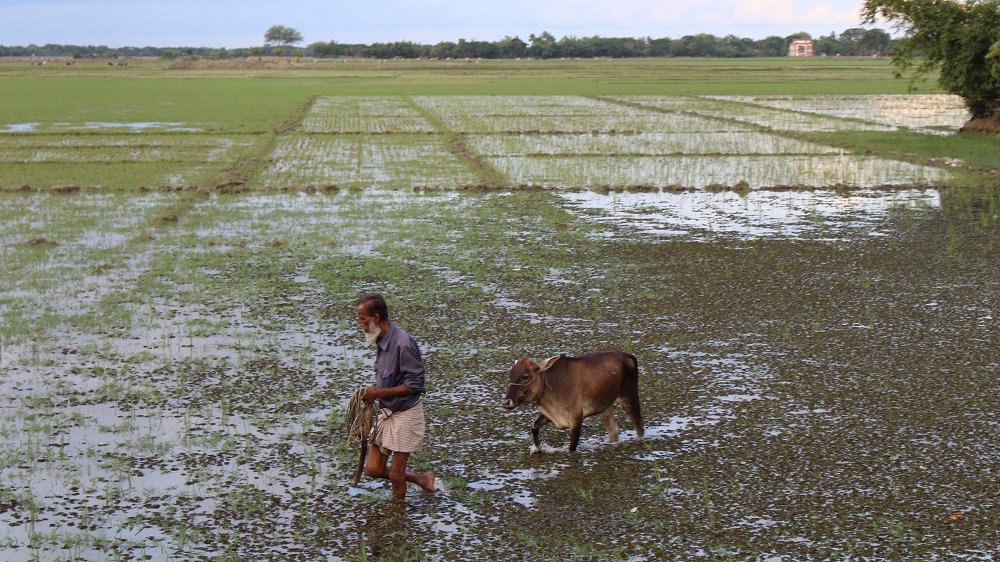 |
| As the arable soil has become too salty to support traditional crops such as rice, men in rural areas have been forced to move to the city to find work [Neha Thirani Bagri/The GroundTruth Project] |
While climate-induced migration on the southwest coast has been rising steadily, Bangladesh’s government does not believe that abandoning the region is the answer.
“These people are very resilient. They are born there, brought up there, they know how to live there,” says Nurul Quadir, joint secretary at Bangladesh’s Ministry of Environment and Forests. “They don’t want to migrate. Only when there is no way, only then people will move.”
|
|
Quadir says the government’s efforts are currently directed at helping people adapt and stay where they are. The government is trying to support the creation of alternative livelihoods by developing crops that can grow in salty water, such as saline-resistant rice.
The government is also providing deeper tube wells, building higher walls around ponds to prevent seawater from entering, supporting efforts to harvest rainwater, raising embankments along the coast, building drainage systems to remove saline water from ponds, and carrying out pilot projects at desalinisation plants, he explains.
However, climate change experts believe these adaptation strategies to help people stay where they are, are simply a palliative short-term cure.
“You have to help the people with the problem they have today,” says Saleemul Huq, director of the International Centre for Climate Change and Development at the Independent University, Bangladesh. “But you also have to think of the problems tomorrow and [the] day after.”
With sea levels expected to rise, Bangladesh’s geography makes climate-change migration in the coming decades a certainty. About 13 percent of the country’s land is made of up low-lying coastal areas that account for about 18 percent of the population – close to 30 to 40 million people. This area would be inundated with a one-metre rise in sea levels – which is a certainty, says Huq. About 20 million people will be displaced in Bangladesh in the coming five years, according to the Intergovernmental Panel on Climate Change.
In order to enable their migration, the government needs to work on helping people develop their skills so that they can thrive in cities, Huq believes. The key to doing that is education – so that their children do not have to be farmers, but can get jobs in cities and towns and facilitate migration for the whole family when the time is right.
It is also imperative to develop other urban centres, so that Dhaka, one of the fastest growing megacities in the world, with a population of well over 15 million people already, is not forced to bear the entire burden.
 |
| Women from Kochukhali. The saline water has a negative impact on the health of mothers and children, including more cases of hypertension in pregnant women, and a higher rate of infant mortality [Neha Thirani Bagri/The GroundTruth Project] |
However, any policy that grapples with climate-induced migration must take into account the disproportionate impact the phenomenon has on women.
“Policies are currently failing to understand the scale and impact of migration on women,” stated a December 2016 report by ActionAid on climate-induced migration in South Asia.
“Promotion of women’s empowerment, as well as women-led planning and disaster response, must be part of the solution,” the report said.
Some efforts are already under way. “We are working to increase the skills of women, so when they are forced to migrate they will have some skills with them,” says Dilruba Haider, of the UN.
“So that wherever they go they can sell their skills, instead of just selling their bodies and ending up in brothels.”
INTERACTIVE: The Lungs of the Earth
Back in the village of Kochukhali, Khadija sits on her porch – an extension of the raised mud platform on which her house is built. To avoid inundation from frequent flooding, most of the mud homes in the village are built just over a metre above the ground.
Her husband, Habibur, would like to return permanently to his village but is afraid he will not be able to make ends meet there.
Khadija has become despondent about her future. The little hope she has, she pins on a brighter life for her son.
“Now I have to take care of him more than myself,” she says, pulling him on to her lap and wiping his nose. “Now I don’t look at my happiness.”
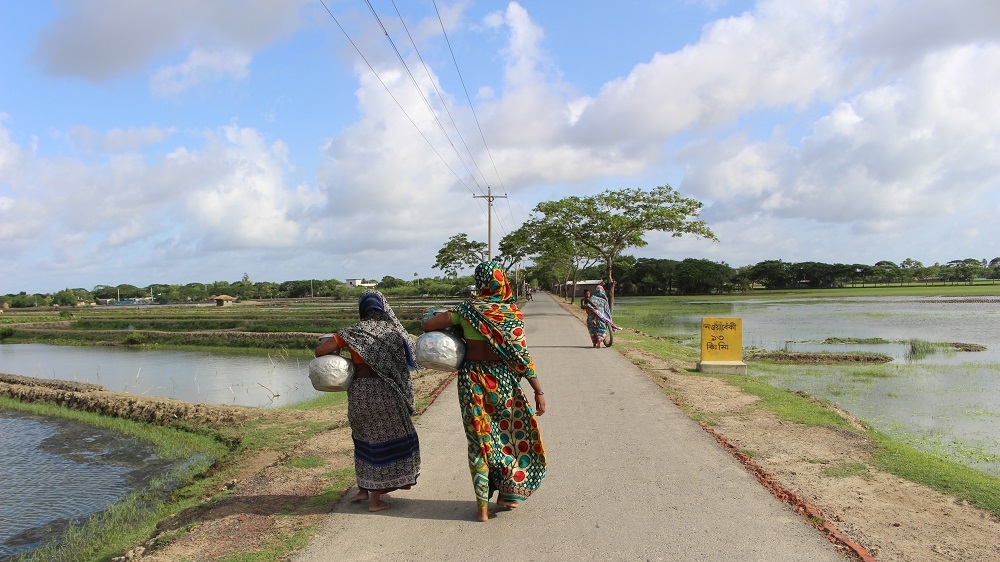 |
| Bangladesh’s reliance on agriculture, high population density and climatic conditions make it one of the most vulnerable countries in the world to climate change [Neha Thirani Bagri/The GroundTruth Project] |
Reporting for this story was supported by the Overseas Press Club Foundation and The GroundTruth Project.
Source: Al Jazeera









A detailed insightful article, except it skips the fact that India by witholding water through its series of barrages constructed at the river heads, is one of the main culprits for Bangladesh’s water crises and its attendant problems….the typical biased story writing by an Indian journo